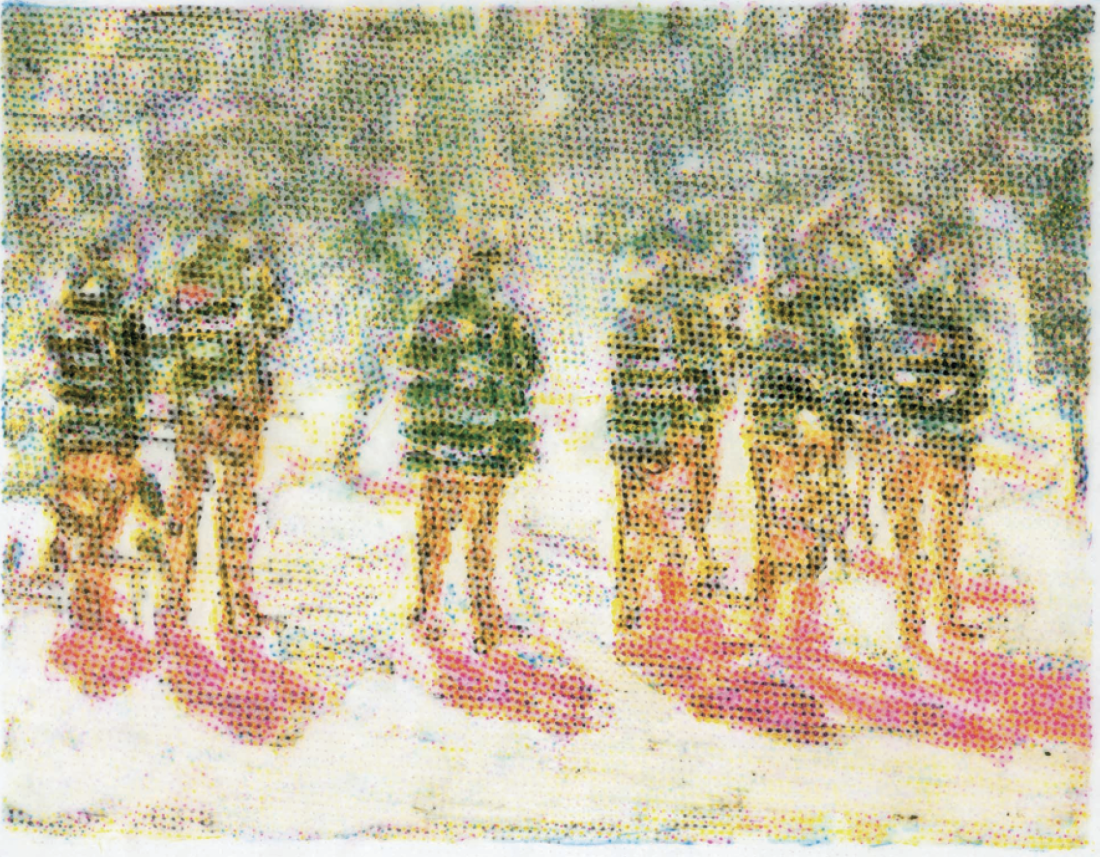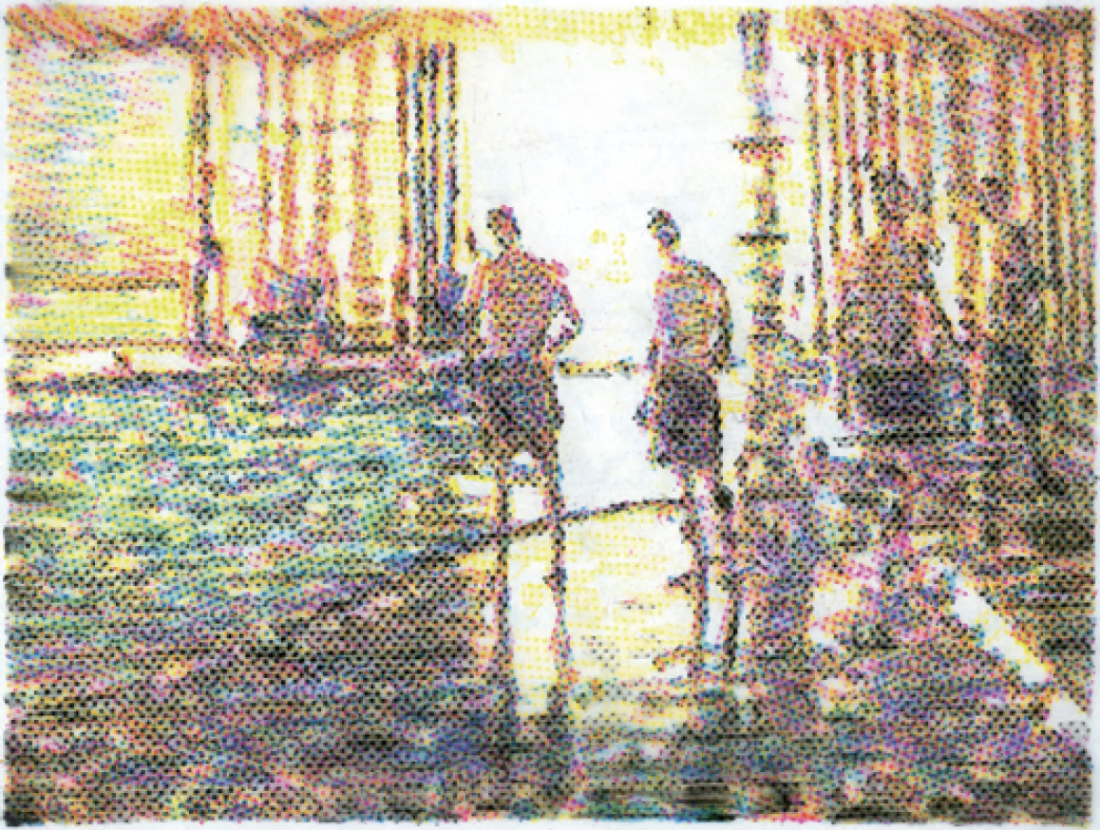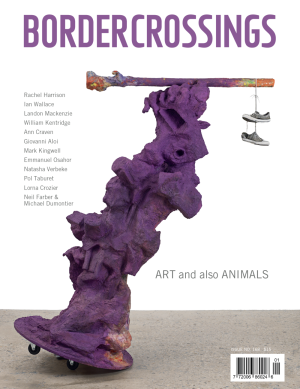Stephen Andrews
Photography did not kill painting; television did. Sure, mechanical reproduction dealt death blows to the painter’s craft some hundred-plus years ago but, judging from the large-scale portraits, tableaux and landscapes that appear in light boxes or mounted on aluminium in leading museums around the world, photography successfully resuscitated painting as a representational medium and continues to keep it on life support. Electronic reproduction is another thing. Photographs are motionless and so are paintings, but television resists stability, its surface an endless discharge of vibrating photons, images in constant motion, the flow broken up by cuts, each one distracting you from the previous. Self-reflection sometimes occurs within the screen/ frame but its efficacy as critique is questionable, since TV is an example of an all-absorbing system that coopts everything it touches. Marshall McLuhan (the original Eminem) notwithstanding, contemplation is resisted on every channel. Only when tragedy strikes do I become conscious of the perpetual feed that comes into my home. Wars, floods and riots seen in real time shake me from my stupor and I stare at the screen, which is now effectively a window on the world, a purportedly real world that I’d come to believe in less and less the more I watched television. Just as quickly as these images appear, however, they are replaced by ads or sitcoms or different news stories, and my epiphany is erased.
Visual art responded to the death knell of TV by slowing it down until it became boring (thus forcing the viewer to ask, Why am I watching this?) or turning it into sculpture. Video artists endlessly documented private performances, proto-New Media artists like Nam June Paik disarmed the boob tube to expose its innards, but painters struggled with the challenge of creating an appropriate representation of the TV screen. Painters like Julie Mehretu and Matthew Ritchie describe the furious exchange of digital information we imagine exists between our computers, but only Toronto artist Stephen Andrews’s paintings and drawing pause the video image in a way that isn’t reminiscent of a film still but instead captures the image in all its blurry verisimilitude.

Stephen Andrews, Red Shadows, 2005, crayon rubbing on Mylar mounted on prepared wood panel, 7 3/4 x 10”. Photographs courtesy Paul Petro Contemporary Art, Toronto.
I remember when I was young, I would put my face up against the TV screen and get lost in the confusion of light and image. The things I could see from six feet away disappeared in white static that hurt my eyes. Andrews makes images that freeze the cathode ray but retain the burning sensation. Replacing the glass screen with one of wire, he successfully approximates what we see in a rush on monitors in our homes, offices, elevators, subways and city squares. Drawing over a window screen held down to his canvas, he creates an indistinct collection of coloured dots that the eye gathers together, seeing something recognizable but still unknown. This is a televised moment, a meaningless blur that tells no story, identifies no subject and barely holds onto its coherence. The only way it makes sense is as a fragment of the never-ending, twenty-four-hours-a-day broadcast with its captions and voice-over and conventions to give it meaning. Seen on its own, I have to ask (as I do in front of every art work): what am I seeing? When I pass in front of a television set, I receive whatever information I’m offered. When I stand in front of a painting, I have to work to perceive the possible meanings.
These new drawings are sometimes innocuous (a surfer, a swimmer) and sometimes ominous (a row of cops, an explosion), but they all make me ache for a story that is now inaccessible, lost when Andrews skimmed them from the froth of the information superhighway. His idyllic images rub up against the rougher ones, the first making the second beautiful, the latter making the first sinister. And I pace in the gallery, stepping closer and then stepping back, trying to force definition on these tiny Seurats, framed in white-painted wood that recalls TV monitors. The thousands of coloured dots never resolve themselves into a story and so, like an unrequited lover, I admire them from a distance, learning to love the wait.

Stephen Andrews, Soldiers On Leave II, 2005, crayon rubbing on Mylar mounted on prepared wood panel, 7 5/8 x 10”.
Andrews’s images, gathered from on-line news reports (a further media intervention, adding even more layers between reality and the artist’s canvas) of current events, inherit some of their charge from the themes in his earlier work. From reprinted obituary photos of those who’ve died from AIDS, to paintings based on digital images from the most recent Iraq war, he lovingly documents anonymous victims of indiscriminate tragedy so they won’t be forgotten by the time the commercial break ends.
Television is an amnesia machine and it has an insidious effect on our historical memory. The quicker it brings us the news of the world, the less certain we can be of what has happened. To illustrate this, Andrews and filmmaker John Greyson have also created a series of animated slide shows from a selection of the drawings, placing a different narrative text over each arrangement. The same pictures are made to tell different stories with no one story more authoritative or truthful than the last. Unfortunately, in doing this, the drawings that on their own were charged by the unresolved binary of crayon and pixel suddenly become merely illustrative as they reappear in sequence on an actual monitor. It should be no surprise that that which I pined for as it hung on the wall is too easily lost in the warm, fuzzy embrace of the television. It’s only when I return to the drawing room that I stop watching and start looking again, finding in Andrews’s screen grabs images that truly capture the electronic age. ■
Stephen Andrews’s “POV” was exhibited at Paul Petro Contemporary Art in Toronto from October 14 to November 12, 2005.
Terence Dick is a writer who lives in Toronto.

